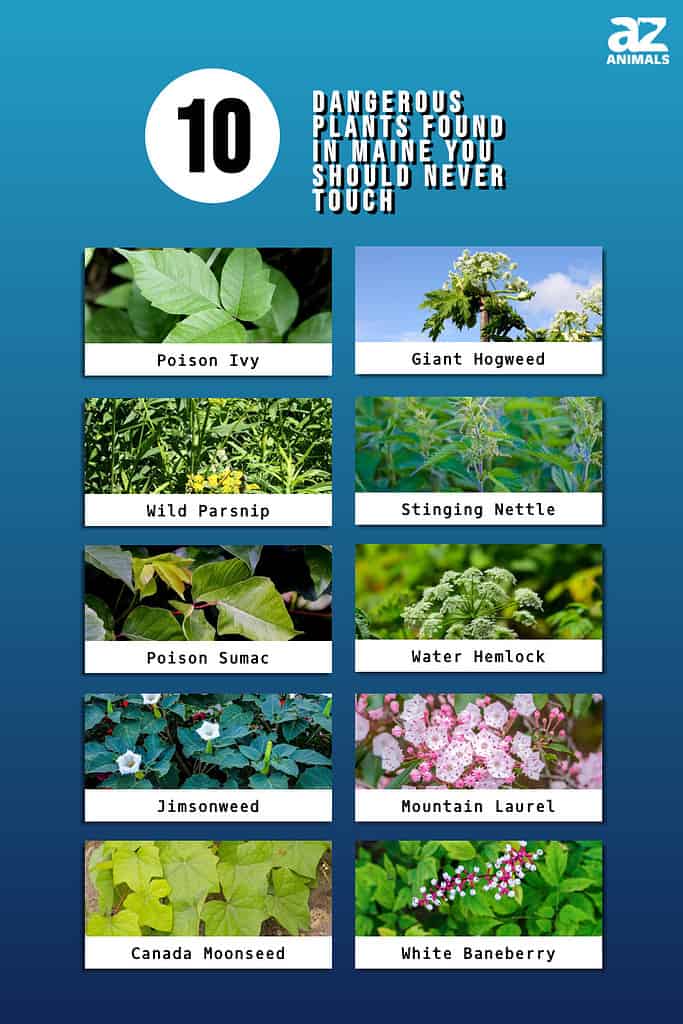
The state of Maine has impressive natural beauty and picturesque landscapes. However, while exploring nature in this enchanting state, knowing the potential risks of poisonous plants is essential. Maine is home to multiple plant species that can cause harm to humans and animals. Touching or ingesting parts of these and other dangerous US plants could cause mild skin irritations or life-threatening allergic reactions. With that in mind, let’s learn more about 10 dangerous plants found in Maine you should never touch and why. Some might already be familiar to you, but the ones you don’t know about could pose the highest risk to you, your family, and your pets.
1. Poison Ivy (Toxicodendron radicans)
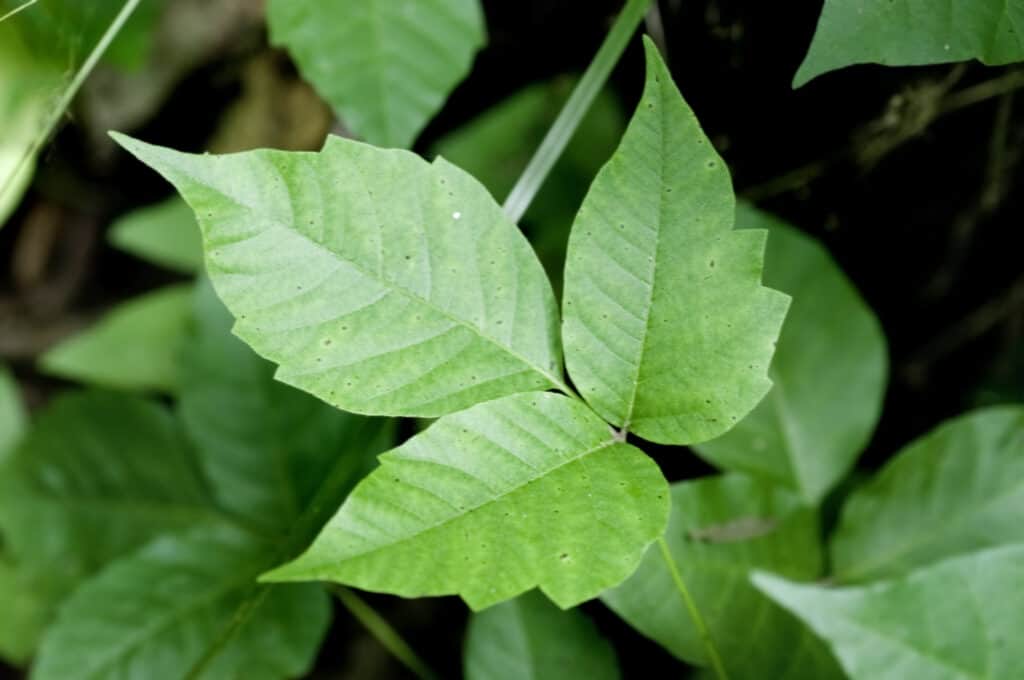
The poison ivy plant has foliage in 3-leaflet patterns and can trail or climb up to 75 feet.
©Tim Mainiero/Shutterstock.com
Poison ivy is a common and dangerous plant found in Maine’s forests and wooded areas. This poisonous plant has a three-leaf arrangement, yellow-green flowers, and white berries. It’s also a climbing and trailing plant that can stretch up to 75 feet.
Poison Ivy Toxicity
The main toxin in poison ivy is the oil urushiol. This toxin is in poison ivy leaves, stems, and roots. Touching any part of the poison ivy plant can result in mild or severe allergic reactions, including an itchy, blistering rash.
2. Giant Hogweed (Heracleum mantegazzianum)
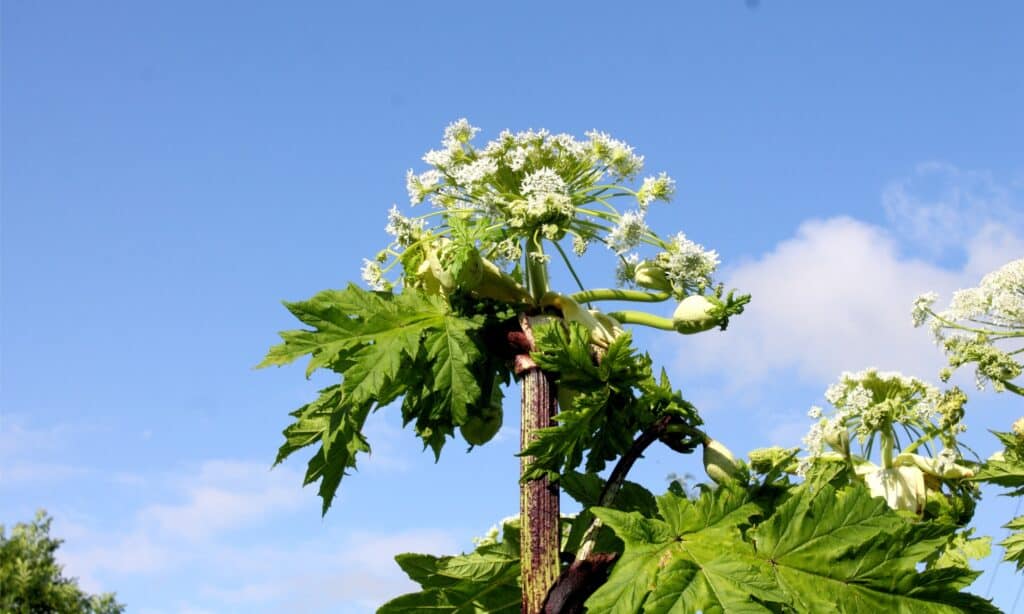
The giant hogweed is an invasive and poisonous plant found in Maine.
©iStock.com/SailsKool
Also called hogsbane and cow parsnip, giant hogweed is a dangerous and invasive plant in Maine. It grows along the edges of wet forests, flood plains, and other areas near water. In addition, this tall plant can reach heights up to 16 feet and has large, umbrella-like white flower clusters. It’s also covered in purple splotches up and down its stems.
Giant Hogweed Toxicity
The giant hogweed is a dangerous plant found in Maine because it contains phototoxic sap that can cause severe burns, blistering, and scars on the skin.
3. Wild Parsnip (Pastinaca sativa)

Don’t touch or eat wild parsnip plants because they contain poisonous toxins.
©R. A. Nonenmacher / CC BY-SA 4.0 – License
Wild parsnip is another invasive plant that grows abundantly along roadsides and in open fields throughout Maine. The foliage of this plant resembles celery leaves, but its umbels of small yellow flowers distinguish it from other plants. But let’s be clear: wild parsnip is a poisonous plant you should never eat. You should also never touch it with bare hands because it could cause a painful skin reaction.
Wild Parsnip Toxicity
The wild parsnip plant contains the toxin furanocoumarins, which can cause severe skin burns and blisters. This action is particularly true when the plants are exposed to sunlight. So it’s essential to wear gloves when handling this wild parsnip.
4. Stinging Nettle (Urtica dioica)

The stinging nettle plant has stinging hairs that can cause skin inflammation and pain.
©iStock.com/Dmitri Zelenevski
The stinging nettle is a dangerous plant found in Maine where the soil is damp, such as in forests, meadows, and riverbanks. The leaves are heart-shaped and serrated, and the stems of this plant are covered in fine, stinging hairs that can cause a painful, itchy rash upon contact.
Stinging Nettle Toxicity
In addition to its stinging hairs, this plant contains nitrogenous compounds like histamine that can cause skin inflammation and discomfort. So though stinging nettle might be used as a medicinal herb, touching this plant with your bare hands will cause pain. Fortunately, the pain is temporary but could last up to a week.
5. Poison Sumac (Toxicodendron vernix)
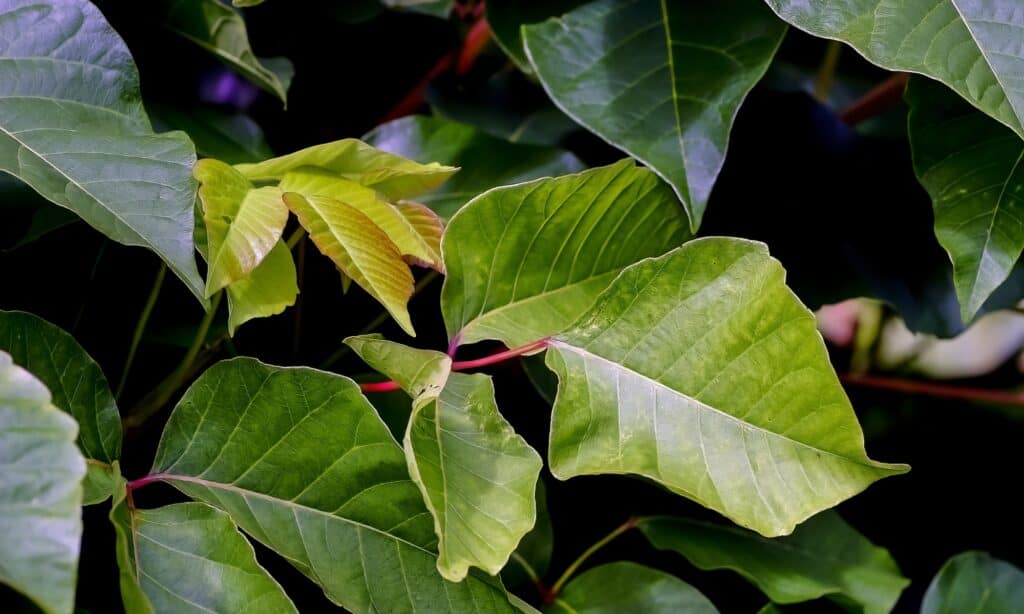
The symptoms of poison sumac poisoning can be worse than the symptoms of poison ivy.
©iStock.com/Werner Meidinger
Poison sumac, a relative of poison ivy, is found in wetlands and swampy areas of Maine. This dangerous plant is a tall, woody shrub with smooth, oval leaves and greenish-white berries. In addition, poison sumac has compound leaves that consist of rows of paired leaflets.
Poison Sumac Toxicity
Like poison oak and poison ivy, poison sumac contains a toxic oil called urushiol that can cause a severe allergic reaction resulting in a blistering rash. Note that the skin-burning sensations and blistering from poison sumac might be more severe than those caused by poison ivy or poison oak.
6. Water Hemlock (Cicuta maculata)
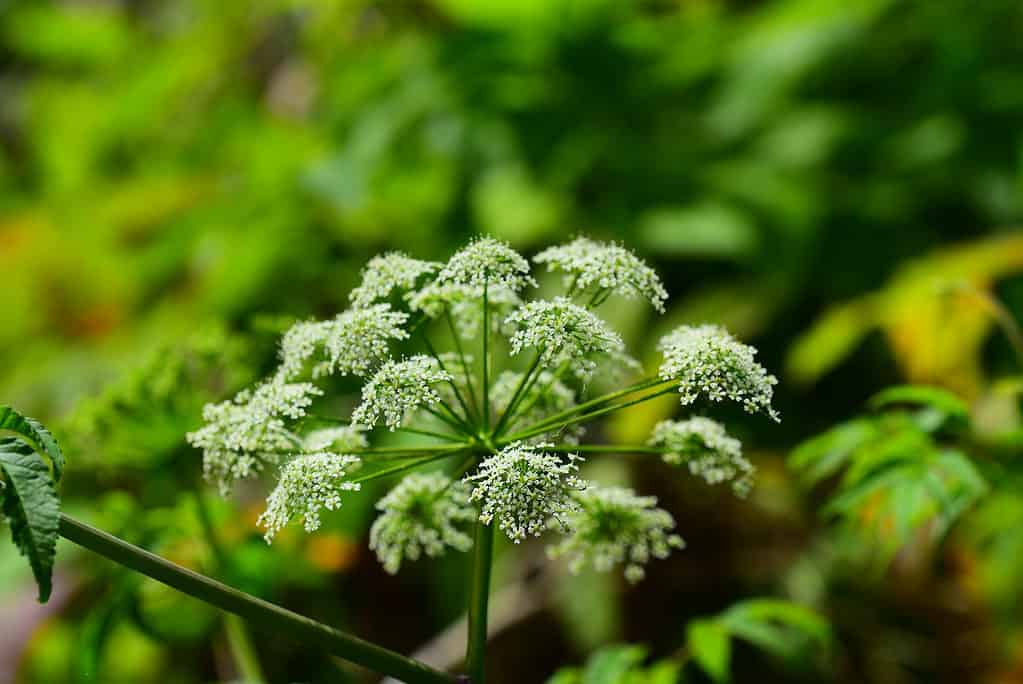
The water hemlock is a very dangerous plant that causes life-threatening poisoning symptoms.
©iStock.com/cturtletrax
Water hemlock or spotted water hemlock is a very dangerous plant found in Maine that you should never touch. It grows in wet areas, including lakes, ponds, marshes, and streams. You can identify this poisonous plant by its spotted stems, tiny white cluster flowers, and erect growth habit.
The water hemlock plant might look like wild carrots or wild parsley, but the biggest difference is this plant’s purple-spotted stems.
Water Hemlock Toxicity
The water hemlock is so dangerous because it contains cicutoxin, an unsaturated alcohol that is highly toxic. Ingesting any part of water hemlock plants can cause seizures, respiratory distress, and even death.
7. Jimsonweed (Datura stramonium)
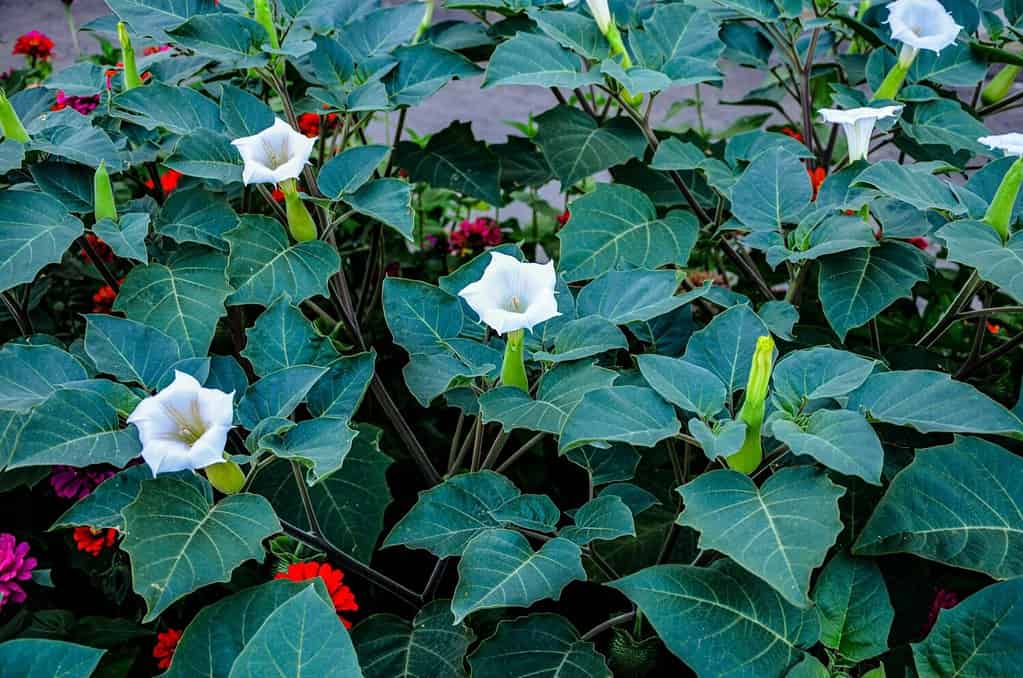
The trumpet flowers of jimsonweed are beautiful, but the whole plant is toxic to humans and animals.
©weha/Shutterstock.com
Jimsonweed, also known as devil’s snare, is a common weed found in disturbed areas throughout Maine. It’s an attractive plant with beautiful trumpet-shaped flowers, bushy foliage, and toothed leaves. It also produces spiny seed pods.
Jimsonweed Toxicity
The jimsonweed plant contains tropane alkaloids that are highly toxic. Ingesting any part of this psychoactive plant can cause hallucinations, convulsions, coma, and death.
8. Mountain Laurel (Kalmia latifolia)

Common in the Eastern United States, mountain laurel is a toxic plant with pretty hexagonal flowers.
©JayL/Shutterstock.com
One of the dangerous native plants found in Maine is the mountain laurel plant, which is common in the Eastern US. This beautiful evergreen shrub has clusters of hexagonal pink or white flowers that bloom in early summer. You can find mountain laurel plants growing wild in woodlands and on rocky slopes. But don’t eat any part of this plant! In fact, mountain laurel is so toxic that bees carry the toxins in their bodies, which can make their honey poisonous to humans.
Mountain Laurel Toxicity
Grayanotoxins are the main compounds in mountain laurel plants that make them poisonous. Touching mountain laurel plants may also cause minor skin irritation. However, ingesting any part of the plant could cause serious symptoms like burning sensations, nausea, vomiting, weakness, drowsiness, coma, and death.
9. Canada Moonseed (Menispermum canadense)
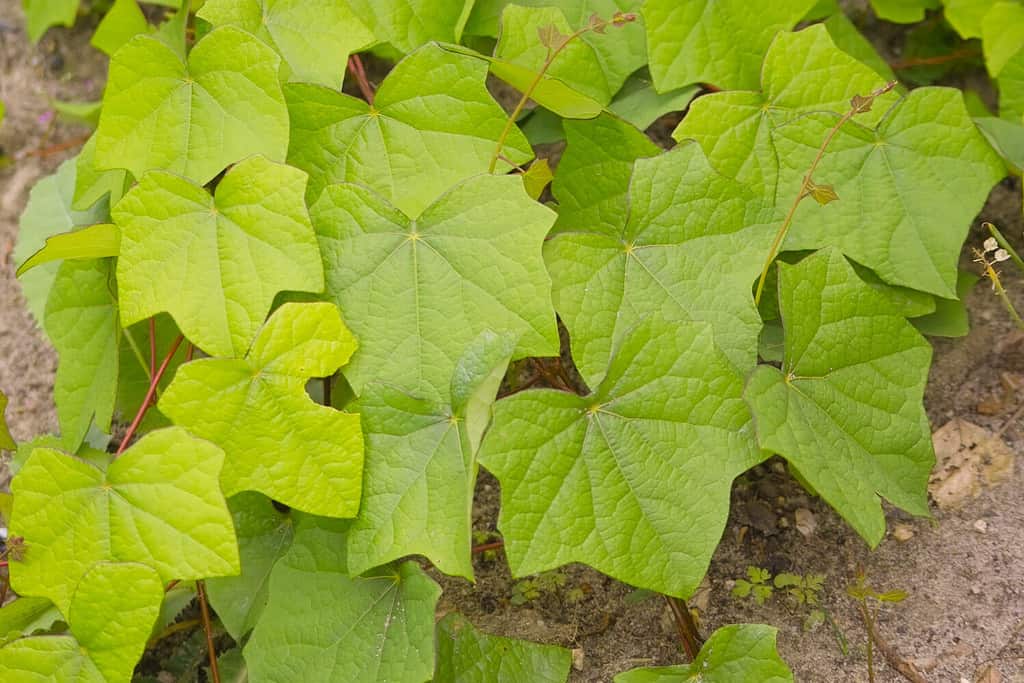
The Canada moonseed is a poisonous climbing vine with seeds that look like tiny crescent moons.
©Ole Schoener/Shutterstock.com
Canada moonseed is a climbing vine found in wooded areas and along streams. This dangerous plant found in Maine is common along the Atlantic coastline from southern Canada to Florida. Its ovate leaves resemble those of grapevines, and its seeds look like little crescent moons.
Canada Moonseed Toxicity
All parts of the Canada moonseed plant are poisonous because of a toxic alkaloid it produces called dauricine. Ingesting parts of this plant, especially the seeds, could cause symptoms such as vomiting, abdominal pain, confusion, convulsions, and death.
10. White Baneberry (Actaea pachypoda)
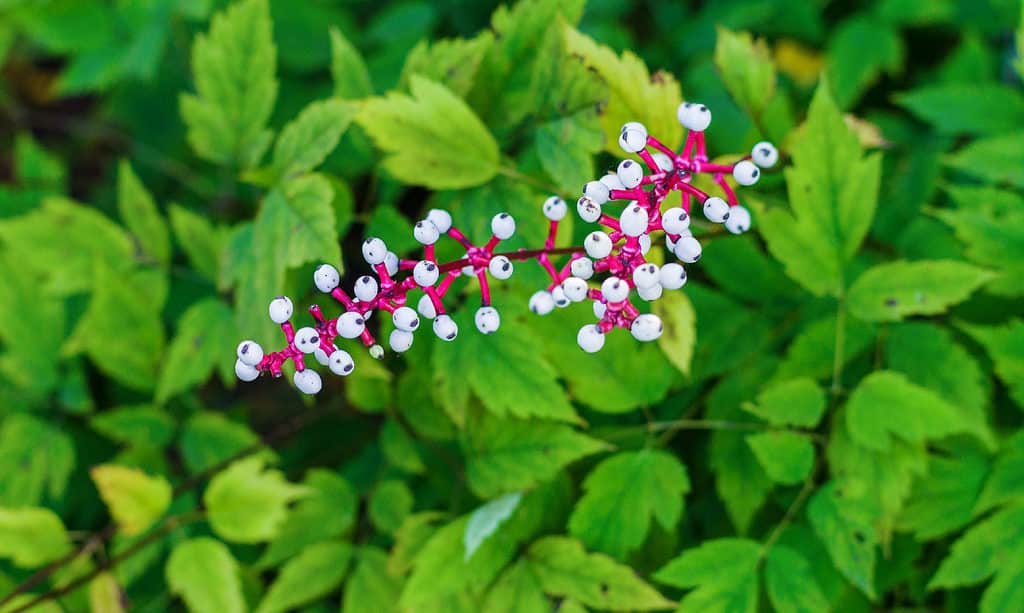
The white baneberry is a poisonous plant that has distinctive white berries with black dots.
©Alex Polo/Shutterstock.com
The white baneberry, or doll’s eyes plant, is a branching herbaceous perennial that grows up to 4 feet tall. It has large green leaves in 3-leaflet patterns, white flowers, and white berries with black dots. White baneberry grows in wet wooded areas with plenty of shade.
There is also a red baneberry plant (Actaea rubra) that produces red berries. Both white and red baneberry plants are poisonous.
White Baneberry Toxicity
The white baneberry plant contains a toxin called ranunculin, plus cardiogenic toxins. Ingesting these compounds could cause nausea, vomiting, diarrhea, dizziness, delirium, and circulatory failure.
Be aware of the dangerous plants found in Maine.
Exploring Maine’s natural beauty, like its national parks, can be a highlight reel experience. Nevertheless, it’s important to be aware of the potential dangers of poisonous plants you may come across. By familiarizing yourself with these and other dangerous plants found in Maine, you can ensure a safer outdoor adventure.
Always wear protective clothing, like gloves and long sleeves, when handling plants in unfamiliar territory. If you suspect you might have plant poisoning, contact poison control for support or 911 for emergency medical assistance. Stay informed, stay cautious, and enjoy all the beauty that Maine has to offer!
Summary of 10 Dangerous Plants Found in Maine You Should Never Touch
| Plant | Latin Name | |
|---|---|---|
| 1 | Poison Ivy | Toxicodendron radicans |
| 2 | Giant Hogweed | Heracleum mantegazzianum |
| 3 | Wild Parsnip | Pastinaca sativa |
| 4 | Stinging Nettle | Urtica dioica |
| 5 | Poison Sumac | Toxicodendron vernix |
| 6 | Water Hemlock | Cicuta maculata |
| 7 | Jimsonweed | Datura stramonium |
| 8 | Mountain Laurel | Kalmia latifolia |
| 9 | Canada Moonseed | Menispermum canadense |
| 10 | White Baneberry | Actaea pachypoda |
The photo featured at the top of this post is © lenic/Shutterstock.com
Thank you for reading! Have some feedback for us? Contact the AZ Animals editorial team.







